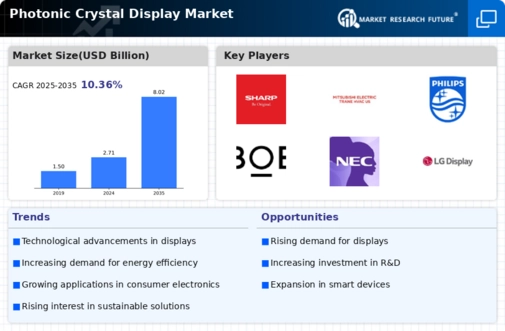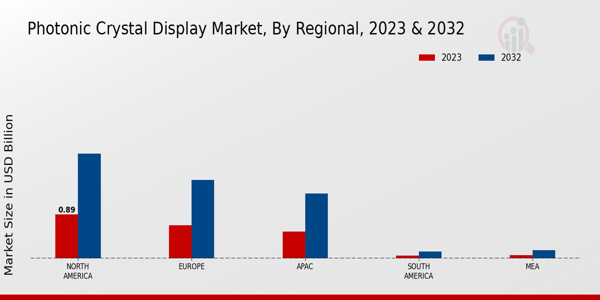Market Growth Projections
The Global Photonic Crystal Display Market Industry is projected to experience substantial growth in the coming years. With a market value of 2.71 USD Billion in 2024, it is anticipated to reach 8.02 USD Billion by 2035. This growth reflects a compound annual growth rate (CAGR) of 10.37% from 2025 to 2035, driven by various factors including technological advancements, rising demand for energy-efficient displays, and increased adoption in consumer electronics and automotive applications. These projections indicate a robust and dynamic market landscape.
Technological Advancements
The Global Photonic Crystal Display Market Industry is experiencing rapid technological advancements that enhance display quality and efficiency. Innovations in materials science, particularly the development of new photonic crystal structures, allow for improved light manipulation and color accuracy. For instance, the integration of nanostructured materials is likely to lead to displays with higher resolution and lower energy consumption. As a result, the market is projected to grow from 2.71 USD Billion in 2024 to 8.02 USD Billion by 2035, indicating a robust demand for advanced display technologies.
Expansion in Automotive Applications
The automotive sector is emerging as a key growth area for the Global Photonic Crystal Display Market Industry. With the rise of smart vehicles and advanced driver-assistance systems, there is a growing need for high-quality displays that provide critical information to drivers. Photonic crystal displays offer advantages such as improved visibility under various lighting conditions and reduced glare. As automotive manufacturers increasingly integrate these displays into their designs, the market is poised for substantial growth, aligning with the overall trend towards enhanced vehicle technology.
Growing Adoption in Consumer Electronics
The Global Photonic Crystal Display Market Industry is witnessing a surge in adoption within the consumer electronics sector. Devices such as smartphones, tablets, and televisions increasingly incorporate photonic crystal technology to enhance visual experiences. This trend is driven by consumer preferences for high-definition displays that provide vibrant colors and superior contrast. As manufacturers strive to meet these demands, the market is expected to expand significantly, reflecting the broader shift towards advanced display technologies in everyday consumer products.
Rising Demand for Energy-Efficient Displays
Energy efficiency is becoming increasingly crucial in the Global Photonic Crystal Display Market Industry. As consumers and industries seek sustainable solutions, photonic crystal displays offer a compelling alternative due to their lower power consumption compared to traditional displays. This shift is particularly evident in sectors such as consumer electronics and automotive, where energy-efficient displays can significantly reduce operational costs. The anticipated growth of the market, with a CAGR of 10.37% from 2025 to 2035, underscores the importance of energy efficiency in driving market expansion.
Increased Investment in Research and Development
Investment in research and development is a driving force behind the Global Photonic Crystal Display Market Industry. Governments and private entities are recognizing the potential of photonic technologies and are allocating resources to foster innovation. This investment is likely to lead to breakthroughs in display technology, enhancing performance and reducing costs. As R&D efforts continue to yield new applications and improvements, the market is expected to benefit from a steady influx of innovative products, further propelling its growth trajectory.

















Leave a Comment